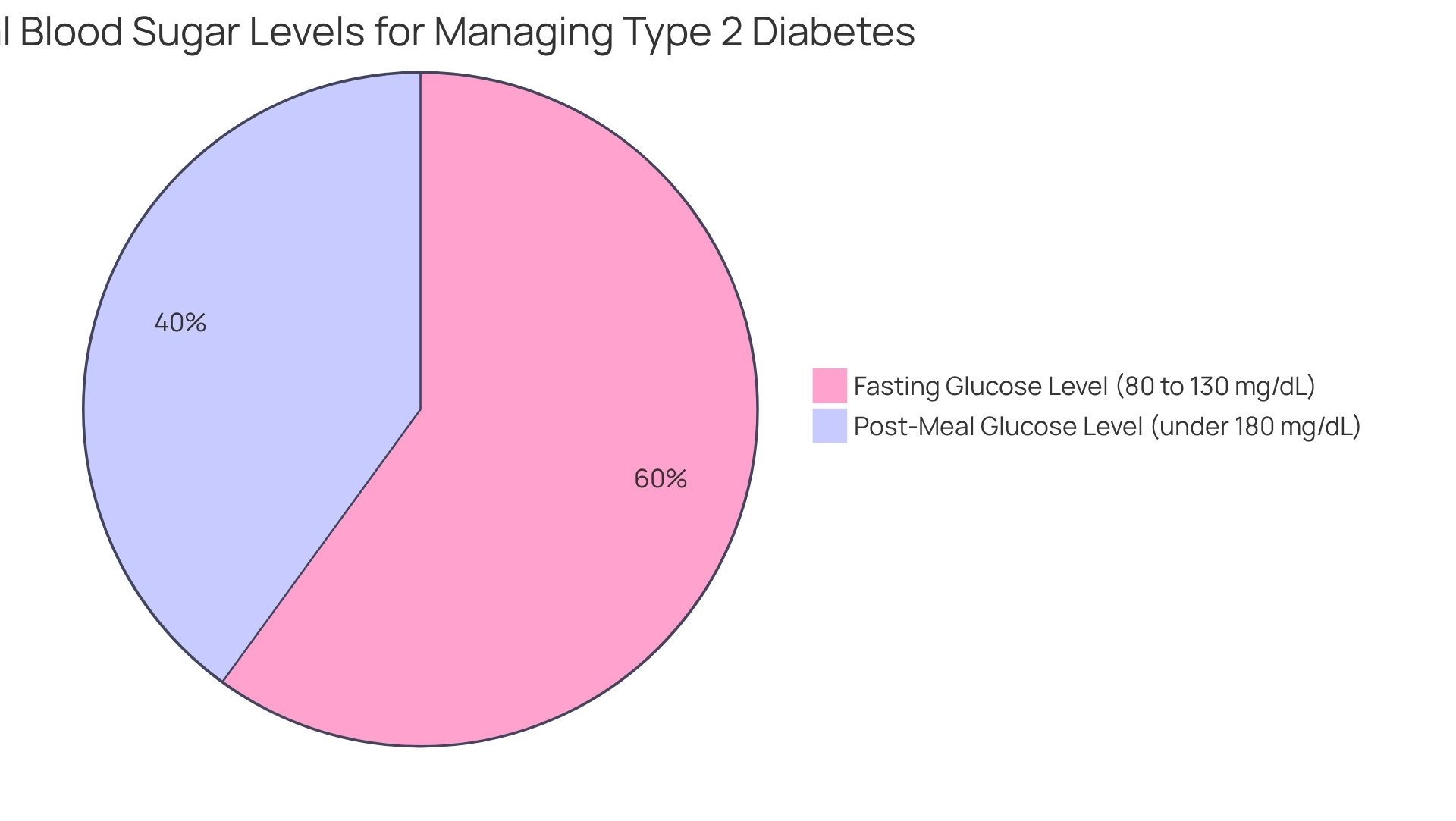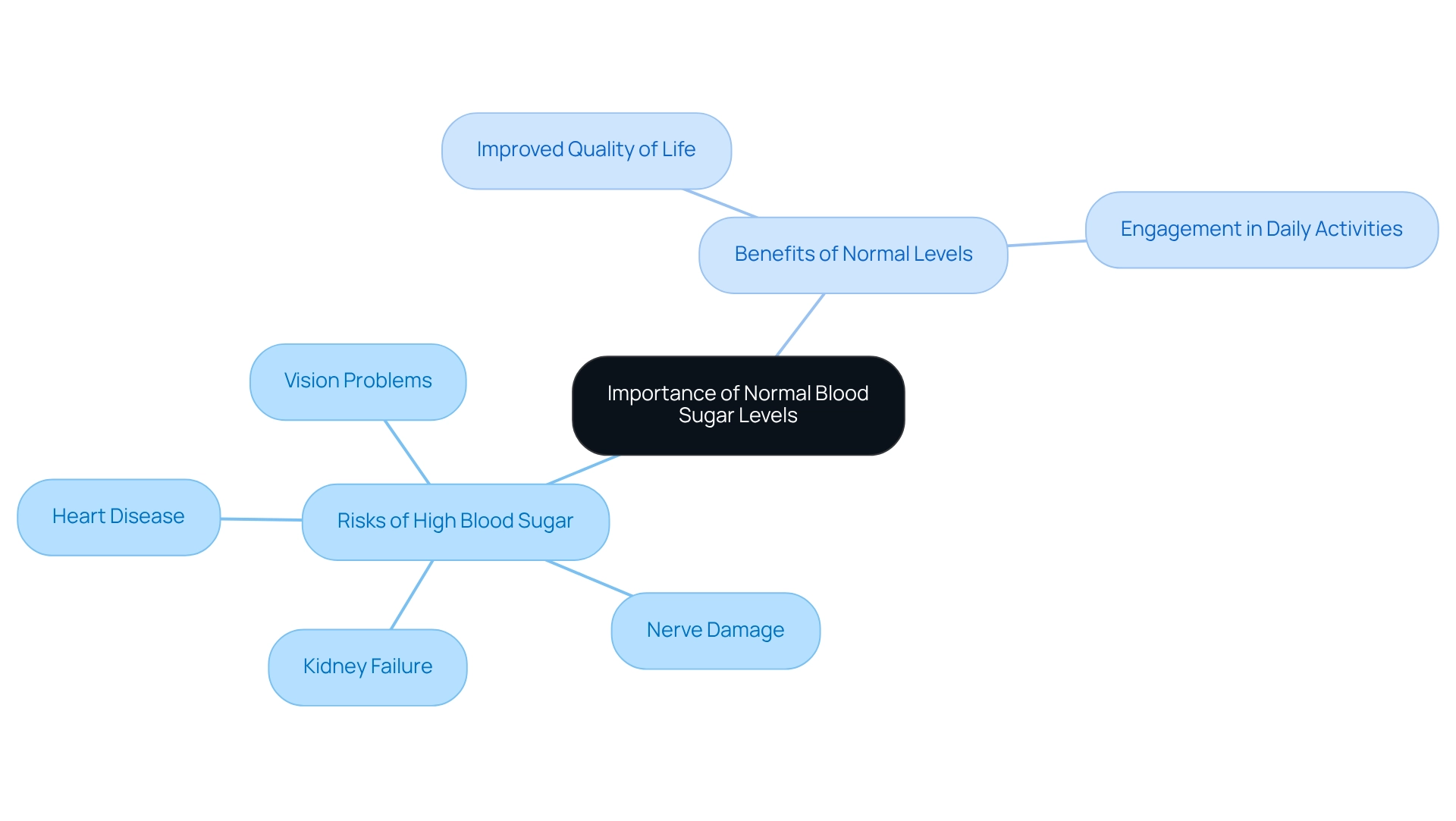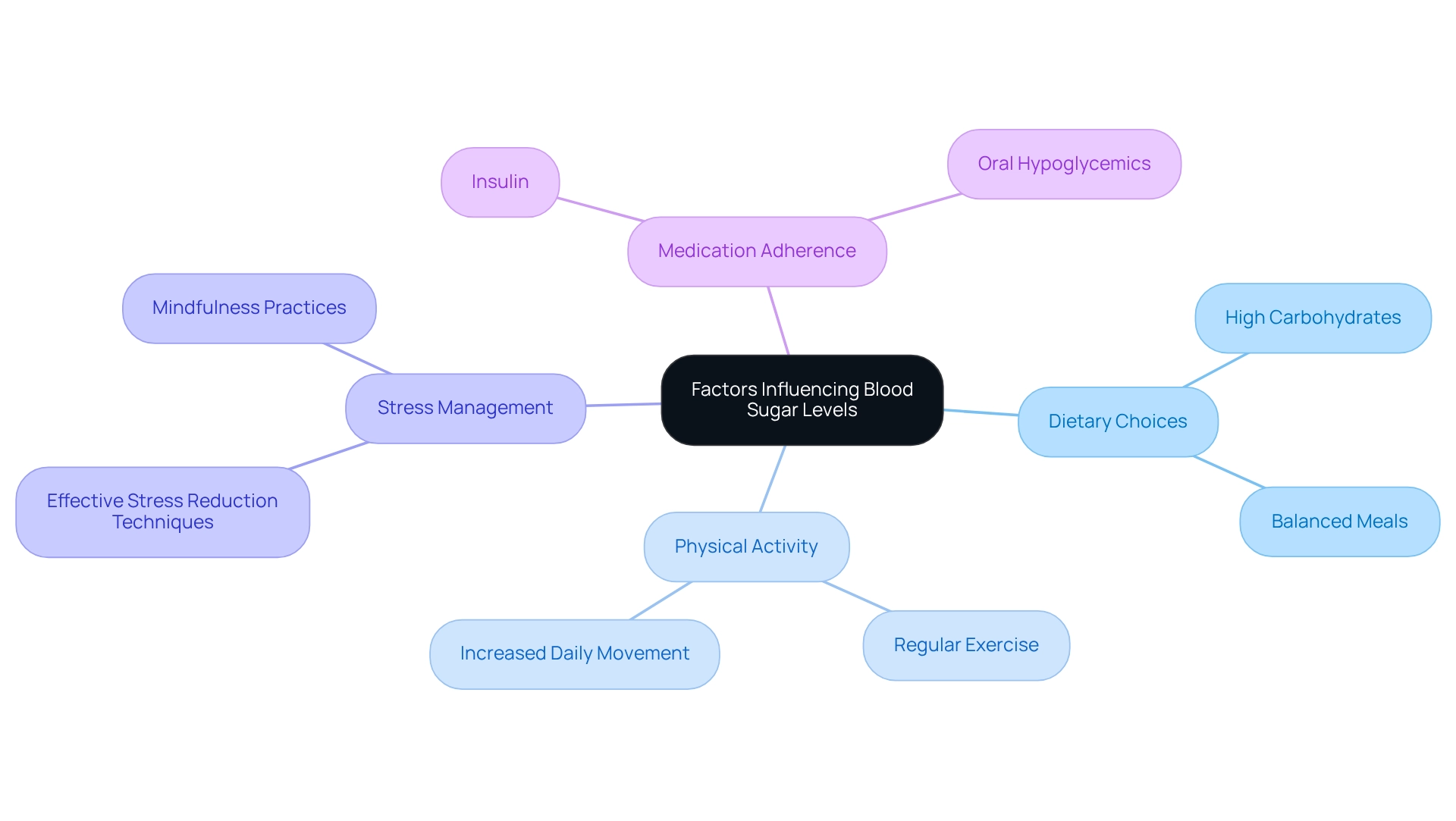Overview
For individuals navigating the journey of Type 2 Diabetes, maintaining normal blood sugar levels is vital. Ideally, these levels should range from 80 to 130 mg/dL when fasting and under 180 mg/dL after meals. It's understandable to feel overwhelmed by these numbers, but knowing them can empower you in your health journey.
Keeping your blood sugar within these ranges is crucial for reducing the risk of complications associated with diabetes. Regular monitoring and personalized management strategies can make a significant difference in achieving optimal health outcomes. Remember, you're not alone in this journey; many resources and support systems are available to help you.
We encourage you to explore options for regular check-ins with healthcare professionals and connect with others who share similar experiences. Together, we can foster a community of support and understanding. You deserve to feel confident and informed as you manage your health.
Introduction
In the journey of managing Type 2 Diabetes, understanding blood sugar levels is paramount. It's understandable to feel overwhelmed, but with the right benchmarks—such as fasting levels between 80 to 130 mg/dL and post-meal readings below 180 mg/dL—you can take proactive steps toward better health. These guidelines not only aid in preventing complications but also empower you to collaborate effectively with your healthcare providers.
Real-life examples, like the positive impact of exercise on blood sugar management, highlight the need for personalized strategies. Remember, each person's experience with diabetes can vary significantly, and you're not alone in this journey. As resources like T2DSolutions emerge to support diabetes education, the importance of regular monitoring and informed decision-making becomes even clearer. Together, we can pave the way for improved quality of life and overall well-being.
Define Normal Blood Sugar Levels for Type 2 Diabetes
Managing Type 2 Diabetes effectively is vital for your health and well-being, and knowing what is a normal blood sugar for type 2 diabetes can make a significant difference. Ideally, fasting glucose levels should fall between 80 to 130 mg/dL (4.4 to 7.2 mmol/L). After meals, it's important to keep glucose concentrations under 180 mg/dL (10.0 mmol/L) within 1 to 2 hours. These benchmarks serve as essential guidelines that can help both you and your healthcare provider in monitoring and adjusting your treatment plans.
Consider how practical examples highlight the importance of maintaining these standards. For instance, a case study on exercise and glucose management illustrates that physical activity can lower glucose levels. However, it's crucial to approach this with caution, especially during episodes of severe hyperglycemia. This dual role of exercise underscores the need for personalized management strategies, as what works for one person may not be suitable for another.
As T2DSolutions emerges as a comprehensive resource for Type 2 and Type 3 diabetes education, it emphasizes the necessity of regularly tracking your glucose readings. Recent insights from specialists reinforce this message, suggesting that if you notice frequent spikes or drops in your glucose levels, it's essential to consult with your healthcare provider about adjusting your management plan. Adhering to what is a normal blood sugar for type 2 diabetes is recognized as a fundamental aspect of diabetes care, which empowers you to make informed choices about your health and treatment options. Moreover, understanding that 15 g of carbohydrates can come from sources like 4 glucose tablets, half a cup of juice, or a tablespoon of honey is vital for managing low glucose levels. T2DSolutions is committed to providing regular updates to educational resources, ensuring you have access to the most accurate and relevant information to support your diabetes management journey. Remember, you're not alone in this journey; we are here to support you every step of the way.

Explain the Importance of Normal Blood Sugar Levels
For those living with Type 2 Diabetes, understanding what is a normal blood sugar for type 2 diabetes is crucial in maintaining typical glucose concentrations. It significantly reduces the risk of complications such as:
- heart disease
- nerve damage
- kidney failure
- vision problems
When glucose levels remain consistently high, it can lead to a condition known as hyperglycemia, which may cause symptoms like:
- excessive thirst
- frequent urination
- fatigue
Over time, uncontrolled glucose can result in serious health issues, making it essential for individuals to regularly check their readings and understand what is a normal blood sugar for type 2 diabetes while adhering to their treatment plans.
It's understandable to feel overwhelmed, but achieving and sustaining healthy glucose levels can greatly improve your overall quality of life. It allows you to engage more fully in daily activities without the burden of diabetes-related complications.
Remember, you’re not alone in this journey; we are here to support you every step of the way. By taking proactive steps, you can empower yourself to manage your health effectively.

Identify Factors Influencing Blood Sugar Levels
Managing glucose concentrations can feel overwhelming for those with Type 2 Diabetes, but understanding what is a normal blood sugar for type 2 diabetes can empower you. Dietary choices, physical activity, stress management, and medication adherence all significantly impact what is considered a normal blood sugar for type 2 diabetes. For instance, meals high in carbohydrates can lead to spikes in glucose, whereas regular exercise can improve insulin sensitivity and help lower those levels. It’s also important to recognize that stress can trigger hormonal changes that may elevate glucose levels, making effective stress management a vital part of your diabetes care.
Medications, including insulin and oral hypoglycemics, are essential tools for regulating glucose levels. By grasping these factors, you can make informed lifestyle choices that enhance your treatment journey and lead to better blood sugar control, which includes knowing what is a normal blood sugar for type 2 diabetes. Remember, as Peter M. House wisely noted, 'Diabetes is not a burden, but a lesson in perseverance and self-care.' This perspective is particularly valuable for those newly diagnosed, as it encourages a focus on gradual progress and self-compassion.
At T2DSolutions, we are dedicated to providing you with valuable resources and support to navigate these challenges effectively. Our case study, 'Taking One Day at a Time,' serves as a gentle reminder to approach health challenges with patience. Small, manageable steps can lead to significant improvements over time. Additionally, exploring diverse management strategies, such as those advocated by Dr. Dinesh Kacha, who promotes reversing diabetes through an Ayurvedic lifestyle, can offer further insights into effective diabetes care. Remember, you’re not alone in this journey; we are here to support you every step of the way.

Conclusion
Understanding and maintaining normal blood sugar levels is essential for effectively managing Type 2 Diabetes. By adhering to established benchmarks—such as fasting levels between 80 to 130 mg/dL and post-meal readings under 180 mg/dL—you can significantly reduce the risk of severe complications associated with this condition. Regular monitoring and personalized strategies, including exercise and dietary management, empower you to take control of your health and enhance your quality of life.
Several influential factors, including diet, physical activity, stress, and medication adherence, play a critical role in blood sugar regulation. Recognizing these elements can help you make informed lifestyle choices that contribute to better blood sugar control. While the journey of managing diabetes may present challenges, it also offers opportunities for personal growth and self-care. Resources like T2DSolutions are here to provide the support and education you need to navigate these complexities.
Ultimately, the path to managing Type 2 Diabetes involves informed decision-making and proactive health management. By remaining vigilant about your blood sugar levels and utilizing available resources, you can enhance your well-being and engage more fully in your daily life. Embracing this journey with patience and perseverance will lead to meaningful improvements and a brighter future. Remember, you're not alone in this journey; we are here to support you every step of the way.
Frequently Asked Questions
What are the normal blood sugar levels for someone with Type 2 Diabetes?
Normal fasting glucose levels for Type 2 Diabetes should fall between 80 to 130 mg/dL (4.4 to 7.2 mmol/L). After meals, glucose concentrations should be kept under 180 mg/dL (10.0 mmol/L) within 1 to 2 hours.
Why is it important to maintain normal blood sugar levels?
Maintaining normal blood sugar levels is vital for health and well-being, as it helps in effectively managing Type 2 Diabetes and can significantly impact treatment plans.
How can physical activity affect blood sugar levels?
Physical activity can lower glucose levels, but it should be approached with caution, especially during episodes of severe hyperglycemia, highlighting the need for personalized management strategies.
What should I do if I notice frequent spikes or drops in my glucose levels?
If you experience frequent spikes or drops in your glucose levels, it is essential to consult with your healthcare provider about adjusting your management plan.
How can I manage low glucose levels effectively?
Understanding that 15 g of carbohydrates can come from sources like 4 glucose tablets, half a cup of juice, or a tablespoon of honey is vital for managing low glucose levels.
What resources are available for Type 2 Diabetes education?
T2DSolutions is a comprehensive resource for Type 2 and Type 3 diabetes education, providing regular updates to educational resources and support for diabetes management.



